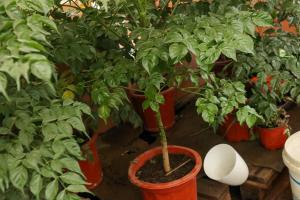What Are Black Spots on Tomato Plant Leaves
Tomatoes are one of the most popular vegetables to grow in the garden. However, they can be vulnerable to various plant diseases, including those that cause black spots on tomato plant leaves. In this article, we will discuss what these black spots are, their causes, and how to treat and prevent them from appearing on tomato plants.
What Are Black Spots on Tomato Plant Leaves?
Black spots on tomato plant leaves are a sign of a fungal infection known as early blight. This disease is caused by the fungus Alternaria solani, which can also affect potatoes and other members of the nightshade family.
Early blight typically starts as small, dark spots on the older and lower leaves of the tomato plant. As the disease progresses, these spots grow larger and develop a target-like pattern with rings of light and dark concentric circles.
If left untreated, early blight can cause the tomato plant to lose its leaves, weaken, and produce fewer or lower-quality fruits.
Causes of Black Spots on Tomato Plant Leaves
Early blight on tomato plants is typically caused by warm and humid weather conditions, especially if the plants are crowded or have poor air circulation. The fungus that causes early blight thrives in moist environments, and it can overwinter in plant debris in the soil and on the plant itself.
Other factors that can increase the likelihood of early blight occurring on tomato plants include over-fertilizing, watering the plants from overhead, and handling them while they are wet.
Treating Black Spots on Tomato Plant Leaves
If you notice black spots on the leaves of your tomato plants, it is important to act quickly to avoid the spreading of the disease. The following steps can help treat early blight:
Remove the affected leaves and dispose of them away from the garden area. This will help prevent the disease from spreading to other plants.
Avoid watering the plants from overhead. Water the soil around the plants instead, and consider using a soaker hose or drip irrigation system.
Apply a copper-based fungicide according to the manufacturer's instructions. This will help to kill the fungus and prevent the disease from spreading further.
Keep the plants pruned and staked to improve air circulation and reduce humidity. This will create a less favorable environment for the fungus to grow.
Preventing Black Spots on Tomato Plant Leaves
The best way to avoid black spots appearing on your tomato plant leaves is through prevention. Here are some tips to help prevent early blight:
Avoid planting tomatoes in the same location year after year. Doing so can increase the chances of plant diseases, including early blight.
Practice crop rotation, and do not plant tomatoes in the same area where you previously grew members of the nightshade family.
Choose tomato varieties that are known to be resistant to early blight, such as Black Krim, Stupice, and Matt's Wild Cherry.
Avoid over-fertilizing, especially with nitrogen-rich fertilizers. Too much nitrogen can cause the plants to produce more foliage and make them more susceptible to fungal diseases.
Conclusion
Black spots on tomato plant leaves are a sign of early blight, a fungal disease that can be detrimental to the health and yield of your tomato plants. Acting quickly and removing the affected leaves, avoiding overhead watering, and applying fungicide can help treat the disease. Additionally, prevention through crop rotation, plant selection, and avoiding over-fertilizing can help prevent the occurrence of black spots on tomato plant leaves in the first place.

 how many times do yo...
how many times do yo... how many planted tre...
how many planted tre... how many pine trees ...
how many pine trees ... how many pecan trees...
how many pecan trees... how many plants comp...
how many plants comp... how many plants can ...
how many plants can ... how many plants and ...
how many plants and ... how many pepper plan...
how many pepper plan...































